Mud volcano
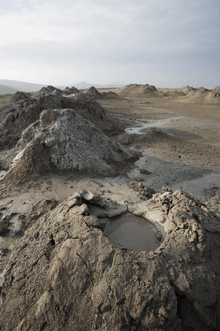




- The geothermal phenomena known as "mud volcanoes" are often not true mud volcanoes (pelovolcano). See mudpot for further information.
Mud volcano or mud dome refers to formations created by geo-exuded mud or slurries, water and gases. There are several geological processes that may cause the formation of mud volcanoes. Mud volcanoes are not true igneous volcanoes as they produce no lava. The Earth continuously exudes a mud-like substance, which may sometimes be referred to as a "mud volcano". Mud volcanoes may range in size from merely 1 or 2 meters high and 1 or 2 meters wide, to 700 meters high and 10 kilometers wide.[1] Smaller mud exudations are sometimes referred to as mud-pots. The largest (man made) mud volcano is "Lusi" in Java, Indonesia, which is 10 kilometres (6 mi) in diameter.[2]
The mud produced by mud volcanoes is most typically formed as hot water, which has been heated deep below the earth's surface, begins to mix and blend with subterranean mineral deposits, thus creating the mud slurry exudate. This material is then forced upwards through a geological fault or fissure due to local subterranean pressure imbalances. Mud volcanoes are associated with subduction zones and about 1100 have been identified on or near land. The temperature of any given active mud volcano generally remains fairly steady and is much lower than the typical temperatures found in igneous volcanoes. Mud volcano temperatures can range from near 100 °C (212 °F) to occasionally 2 °C (36 °F), some being used as popular "mud baths."
About 86% of the gas released from these structures is methane, with much less carbon dioxide and nitrogen emitted. Ejected materials are most often a slurry of fine solids suspended in water that may contain a mixture of salts, acids and various hydrocarbons.
Possible mud volcanoes have been identified on Mars.[3]
Details
A mud volcano may be the result of a piercement structure created by a pressurized mud diapir that breaches the Earth's surface or ocean bottom. Their temperatures may be as low as the freezing point of the ejected materials, particularly when venting is associated with the creation of hydrocarbon clathrate hydrate deposits. Mud volcanoes are often associated with petroleum deposits and tectonic subduction zones and orogenic belts; hydrocarbon gases are often erupted. They are also often associated with lava volcanoes; in the case of such close proximity, mud volcanoes emit incombustible gases including helium, whereas lone mud volcanoes are more likely to emit methane.
Approximately 1,100 mud volcanoes have been identified on land and in shallow water. It has been estimated that well over 10,000 may exist on continental slopes and abyssal plains.
Features
- Gryphon: steep-sided cone shorter than 3 meters that extrudes mud
- Mud cone: high cone shorter than 10 meters that extrudes mud and rock fragments
- Scoria cone: cone formed by heating of mud deposits during fires
- Salse: water-dominated pools with gas seeps
- Spring: water-dominated outlets smaller than 0.5 metres
- Mud shield
Emissions
Most liquid and solid material is released during eruptions, but seeps occur during dormant periods.
The mud is rich in halite (rock salt).
First-order estimates of mud volcano emissions have been made (1 Tg = 1 million metric tonnes).
- 2002: L. I. Dimitrov estimated that 10.2–12.6 Tg/yr of methane is released from onshore and shallow offshore mud volcanoes.
- 2002: Etiope and Klusman estimated at least 1–2 and as much as 10–20 Tg/yr of methane may be emitted from onshore mud volcanoes.
- 2003: Etiope, in an estimate based on 120 mud volcanoes: "The emission results to be conservatively between 5 and 9 Tg/yr, that is 3–6% of the natural methane sources officially considered in the atmospheric methane budget. The total geologic source, including MVs (this work), seepage from seafloor (Kvenvolden et al., 2001), microseepage in hydrocarbon-prone areas and geothermal sources (Etiope and Klusman, 2002), would amount to 35–45 Tg/yr."[4]
- 2003: analysis by Milkov et al. suggests that the global gas flux may be as high as 33 Tg/yr (15.9 Tg/yr during quiescent periods plus 17.1 Tg/yr during eruptions). Six teragrams per year of greenhouse gases are from onshore and shallow offshore mud volcanoes. Deep-water sources may emit 27 Tg/yr. Total may be 9% of fossil CH4 missing in the modern atmospheric CH4 budget, and 12% in the preindustrial budget.[5]
- 2003: Alexei Milkov estimated approximately 30.5 Tg/yr of gases (mainly methane and CO2) may escape from mud volcanoes to the atmosphere and the ocean.[6]
- 2003: Achim J. Kopf estimated 1.97×1011 to 1.23×1014 m³ of methane is released by all mud volcanoes per year, of which 4.66×107 to 3.28×1011 m³ is from surface volcanoes.[7] That converts to 141–88,000 Tg/yr from all mud volcanoes, of which 0.033–235 Tg is from surface volcanoes.
Locations
Europe
Dozens of mud volcanoes can be found on the Taman Peninsula of Russia and the Kerch Peninsula of the Crimean disputed territories. In Italy, they are common in the northern front of the Apennines (e.g., Salse di Nirano) and in Sicily. On August 24, 2013, a mud volcano appeared in the centre of the via Coccia di Morto roundabout in Fiumicino near Rome.[8][9]
Another relatively accessible place where mud volcanoes can be found in Europe are the Berca Mud Volcanoes near Berca in Buzău County, Romania, close to the Carpathian Mountains.
Asia
Indonesia
Drilling may have resulted in the Sidoarjo mud flow on May 29, 2006,[10][11][12] or an earthquake[13][14] in the Porong subdistrict of East Java province, Indonesia. The mud covered about 440 hectares, 1,087 acres (4.40 km2) (2.73 mi2), and inundated four villages, homes, roads, rice fields, and factories, displacing about 24,000 people and killing 14. The gas exploration company involved was operated by PT Lapindo Brantas and the earthquake that may have triggered the mud volcano was the 6.3 magnitude Yogyakarta earthquake of May 27, 2006. In 2008, it was termed the world's largest mud volcano. It is beginning to show signs of catastrophic collapse, according to geologists who have been monitoring it and the surrounding area. A catastrophic collapse could sag the vent and surrounding area by up to 150 metres (490 ft) in the next decade. In March 2008, the scientists observed drops of up to 3 metres (9.8 ft) in one night. Most of the subsidence in the area around the volcano is more gradual, at around 1 millimetre (0.039 in) per day. A study by a group of Indonesian geo-scientists led by Bambang Istadi predicted the area affected by the mudflow over a ten-year period.[15] More recent studies carried out in 2011 predict that the mud will flow for another 20 years, or even longer.[16] Now named Lusi – a contraction of Lumpur Sidoarjo, where lumpur is the Indonesian word for "mud" – the mud volcano appears to be a hydrocarbon/hydrothermal hybrid.
Central Asia
Many mud volcanoes exist on the shores of the Black Sea and Caspian Sea. Tectonic forces and large sedimentary deposits around the latter have created several fields of mud volcanoes, many of them emitting methane and other hydrocarbons. Features over 200 metres (656 ft) high are in Azerbaijan, with large eruptions sometimes producing flames of similar scale (see below).

Iran and Pakistan possess mud volcanoes in the Makran range of mountains in the south of the two countries. The world's largest and highest mud volcano is located in Balochistan, Pakistan. It is known as Baba Chandrakup (literally Father Moonwell) on the way to Hinglaj. It is a pilgrim site for Hindus.[17]
There are mud volcanoes in Georgia, such as at Akhtala.
Azerbaijan
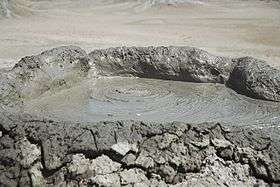
Azerbaijan and its Caspian coastline are home to nearly 400 mud volcanoes, more than half the total throughout the continents.[18] In 2001, one mud volcano 15 kilometres (9 mi) from Baku made world headlines when it started ejecting flames 15 metres (49 ft) high.[19]
In Azerbaijan, eruptions are driven from a deep mud reservoir which is connected to the surface even during dormant periods, when seeping water shows a deep origin. Seeps have temperatures that are generally above ambient ground temperature by 2 °C (3.6 °F) - 3 °C (5.4 °F).[20] Lökbatan Mud Volcano since 1998 submitted to UNESCO's World Heritage Site tentative list.[21]
Iran
There are many mud volcanoes in Iran: in Hormozgan province, Sistan and Baluchestan Province and Golestan Province.
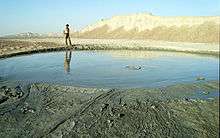
India
The island of Baratang, part of the Great Andaman archipelago in the Andaman Islands, Indian Ocean, has several sites of mud volcanic activity. There was a significant eruption event in 2003.
Pakistan
In Pakistan there are more than 80 active mud volcanoes in Balochistan province; there are about 10 locations with clusters of mud volcanoes. In the west, in Gwadar District, the mud volcanoes are very small and mostly sit in the south of Jabal-e-Mehdi toward Sur Bandar. Many more are in the northeast of Ormara. The remainder are in Lasbela District and are scattered between south of Gorangatti on Koh Hinglaj to Koh Kuk in the North of Miani Hor in the Hangol Valley. In this region, the heights of mud volcanoes range between 800 to 1,550 feet (243.8 to 472.4 m). The most famous is Chandragup. The biggest crater found at 25°33'13.63"N. 65°44'09.66"E is about 450 feet (137.16 m) in diameter. Most mud volcanoes in this region are in out-of-reach areas having very difficult terrain. Dormant mud volcanoes stand like columns of mud in many other areas.
Philippines
In the Turtle Islands, in the province of Tawi-Tawi, the southwestern edge of the Philippines bordering Malaysia, presence of mud volcanoes are evident on three of the islands – Lihiman, Great Bakkungan and Boan Islands. The northeastern part of Lihiman Island is distinguished for having more violent kind of mud extrusions mixed with large pieces of rocks, creating a 20-m (66-ft) wide crater on that hilly part of the island.[22] Such extrusions are reported to be accompanied by mild earthquakes and evidence of extruded materials can be found high in the surrounding trees. Submarine mud extrusions off the island have been observed by local residents.[23]
Other Asian locations
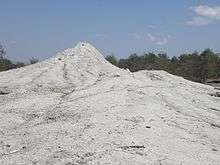
- China has a number of mud volcanoes in Xinjiang province.
- Some active mud volcanoes are in Oesilo (Oecusse District, East Timor). Arthur Wichmann reports a mud volcano in Bibiluto (Viqueque District), which erupted between 1856 and 1879.[24]
- There are mud volcanoes at the Minn Buu Township, Magway division in Myanmar (Burma).
- There are two active mud volcanoes in South Taiwan and several inactive ones. The Wushan Mud Volcanoes (烏山頂泥火山 in Chinese) are in the Yanchao District of Kaohsiung City. There are active mud volcanoes in Wandan township of Pingtung county.
- There are mud volcanoes on the island of Pulau Tiga, off the western coast of the Malaysian state of Sabah on Borneo.
- A drilling accident offshore of Brunei on Borneo in 1979 caused a mud volcano which took 20 relief wells and nearly 30 years to halt.
North America



Mud volcanoes of the North American continent include:
- A field of small (<2 metres (6.6 ft) high) fault-controlled, cold mud volcanoes is on California's Mendocino Coast, near Glenblair and Fort Bragg, California. The fine grained clay is occasionally harvested by local potters.[25]
- Shrub and Klawasi mud volcanoes in the Copper River basin by the Wrangell Mountains, Alaska. Emissions are mostly CO2 and nitrogen; the volcanoes are associated with magmatic processes.
- An unnamed mud volcano 30 metres (98 ft) high and with a top about 100 metres (328 ft) wide, 24 kilometres (15 mi) off Redondo Beach, California, and 800 metres (2,620 ft) under the surface of the Pacific Ocean.
- A field of small (<3 metres (9.8 ft)) mud volcanoes in the Salton Sea geothermal area near the town of Niland, California.[26] Emissions are mostly CO2.
- Smooth Ridge mud volcano in 1,000 metres (3,280 ft) of water near Monterey Canyon, California.
- Kaglulik mud volcano, 43 metres (141 ft) under the surface of the Beaufort Sea, near the northern boundary of Alaska and Canada. Petroleum deposits are believed to exist in the area.
- Maquinna mud volcano, located 16–18 kilometres (9.9–11.2 mi) west of Vancouver Island, British Columbia, Canada.
- There are many mud volcanoes in Trinidad and Tobago in the Caribbean, near oil reserves in southern parts of the island of Trinidad. As of August 15, 2007, the mud volcano titled the Moruga Bouffle was said to being spitting up methane gas which shows that it is active. There are several other mud volcanoes in the tropical island which include:
- the Devils Woodyard mud volcano near Trinidad and Tobago
- the Moruga Bouffe mud volcano near Moruga
- the Piparo mud volcano
- the Chatham mud volcano underwater in the Columbus Channel; this mud volcano periodically produces a short-lived island.
Yellowstone's "Mud Volcano"
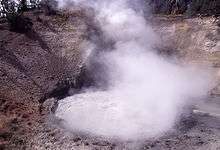
The name of Yellowstone National Park's "Mud Volcano" feature and the surrounding area is misleading; it consists of hot springs, mud pots and fumaroles, rather than a true mud volcano. Depending upon the precise definition of the term mud volcano, the Yellowstone formation could be considered a hydrothermal mud volcano cluster. The feature is much less active than in its first recorded description, although the area is quite dynamic. Yellowstone is an active geothermal area with a magma chamber near the surface, and active gases are chiefly steam, carbon dioxide, and hydrogen sulfide.
However, there are mud volcanoes and mud geysers elsewhere in Yellowstone. One, the "Vertically Gifted Cyclic Mud Pot" sometimes acts as a geyser, throwing mud up to 30 feet high.[28]
The mud volcano in Yellowstone was previously a mound until suddenly it tore itself apart into the formation seen today.[29]
South America
Venezuela
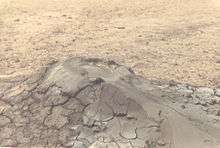
The eastern part of Venezuela contains several mud volcanoes(a.k.a. Mud dome), all of them having an origin related to oil deposits. The mud of 6 kilometres (3.7 mi) from Maturín, Venezuela contains water, biogenic gas, hydrocarbons and an important quantity of salt. Cows from the savanna often gather around to lick the dried mud for its salt content, which is an integral part of their diet needed to produce milk.
Trinidad


There are a number of mud volcanoes near the oil fields in southern Trinidad.
Colombia
Volcan El Totumo,[30] which marks the division between Bolívar and Atlantico in Colombia. This volcano is approximately 50 feet (15 m) high and can accommodate 10 to 15 people in its crater; many tourists and locals visit this volcano due to the alleged medicinal benefits of the mud; it is next to a cienaga, or lake. This volcano is under legal dispute between the Bolivar and Atlantico Departamentos because of its tourist value.
See also
|
|
Notes
- ↑ Kioka, Arata; Ashi, Juichiro (28 October 2015). "Episodic massive mud eruptions from submarine mud volcanoes examined through topographical signatures". Geophysical Research Letters. 42 (20): 8406–8414. doi:10.1002/2015GL065713.
- ↑ "Lusi Mud Volcano". Volcano Live. March 26, 2009. Retrieved 2013-05-24.
- ↑ "Mars domes may be 'mud volcanoes'". BBC. March 26, 2009. Retrieved 2009-03-27.
- ↑ Etiope, Giuseppe (2003). "A NEW ESTIMATE OF GLOBAL METHANE FLUX TO THE ATMOSPHERE FROM ONSHORE AND SHALLOW SUBMARINE MUD VOLCANOES". Geological Society of America Abstracts with Programs. p. 115. "A NEW ESTIMATE OF GLOBAL METHANE FLUX TO THE ATMOSPHERE FROM ONSHORE AND SHALLOW SUBMARINE MUD VOLCANOES". XVI INQUA Congress. Retrieved April 20, 2005.
- ↑ Milkov, A. V., R. Sassen, T. V. Apanasovich, and F. G. Dadashev (2003). "Global gas flux from mud volcanoes: A significant source of fossil methane in the atmosphere and the ocean". Geophys. Res. Lett. 30 (2): 1037. Bibcode:2003GeoRL..30b...9M. doi:10.1029/2002GL016358.
- ↑ "Global Distribution and Significance of Mud Volcanoes". AAPG Annual Meeting 2003: Energy - Our Monumental Task. Archived from the original on November 18, 2005. Retrieved April 20, 2005.
- ↑ Achim J. Kopf (2003). "Global methane emission through mud volcanoes and its past and present impact on the Earth's climate". International Journal of Earth Sciences. 92 (5): 806–816. Bibcode:2003IJEaS..92..806K. doi:10.1007/s00531-003-0341-z. ISSN 1437-3254 (Paper) ISSN 1437-3262 (Online)
- ↑ http://www.euronews.com/2013/08/28/mini-volcano-pops-up-in-rome/
- ↑ http://roma.corriere.it/roma/notizie/cronaca/13_agosto_27/geyser-fiumicino-piccolo-vulcano-2222787658415.shtml
- ↑ Davies, R.J., Brumm, M., Manga, M., Rubiandini, R., Swarbrick, R., Tingay, M. (2008). "The East Java mud volcano (2006 to present): an earthquake or drilling trigger?". Earth and Planetary Science Letters. 272 (3–4): 627–638. Bibcode:2008E&PSL.272..627D. doi:10.1016/j.epsl.2008.05.029.
- ↑ Sawolo, N., Sutriono, E., Istadi, B., Darmoyo, A.B. (2009). "The LUSI mud volcano triggering controversy: was it caused by drilling?". Marine and Petroleum Geology. 26 (9): 1766–1784. doi:10.1016/j.marpetgeo.2009.04.002.
- ↑ Sawolo, N., Sutriono, E., Istadi, B., Darmoyo, A.B. (2010). "Was LUSI caused by drilling? – Authors reply to discussion". Marine & Petroleum Geology. 27 (7): 1658–1675. doi:10.1016/j.marpetgeo.2010.01.018.
- ↑ Mazzini, A., Svensen, H., Akhmanov, G.G., Aloisi, G., Planke, S., Malthe-Sorenssen, A., Istadi, B. (2007). "Triggering and dynamic evolution of the LUSI mud volcano, Indonesia". Earth and Planetary Science Letters. 261 (3–4): 375–388. Bibcode:2007E&PSL.261..375M. doi:10.1016/j.epsl.2007.07.001.
- ↑ Mazzini, A., Nermoen, A., Krotkiewski, M., Podladchikov, Y., Planke, S., Svensen, H. (2009). "Strike-slip faulting as a trigger mechanism for overpressure release through piercement structures. Implications for the LUSI mud volcano, Indonesia". Marine and Petroleum Geology. 26 (8–9): 1751–1765. doi:10.1016/j.marpetgeo.2009.03.001.
- ↑ Istadi, B., Pramono, G.H., Sumintadireja, P., Alam, S. (2009). "Simulation on growth and potential Geohazard of East Java Mud Volcano, Indonesia". Marine & Petroleum Geology, Mud volcano special issue. 26 (9): 1724–1739. doi:10.1016/j.marpetgeo.2009.03.006.
- ↑ Dennis Normile (24 February 2011). "Indonesia's Infamous Mud Volcano Could Outlive All of Us". Science (AAAS). Retrieved 15 April 2011.
- ↑ http://pakistaniat.com/2007/03/02/mud-volcanoes-volcano-balochistan-baluchistan-hingol-offroad-makran-pasni-hinglaj/
- ↑ "MUD VOLCANOES OF AZERBAIJAN". www.atlasobscura.com. Retrieved 29 August 2014.
- ↑ "Azeri mud volcano flares". BBC News. October 29, 2001. Retrieved May 13, 2010.
- ↑ S. Planke; H. Svensen; M. Hovland; D. A. Banks; B. Jamtveit (December 2003). "Mud and fluid migration in active mud volcanoes in Azerbaijan". Geo-Marine Letters. 23 (3–4): 258–268. Bibcode:2003GML....23..258P. doi:10.1007/s00367-003-0152-z.
- ↑ ""Lok-Batan" Mud Cone". whc.unesco.org. Retrieved 29 August 2014.
- ↑ "Geo-physical Features of Philippine Turtle Island". Ocean Ambassadors Track a Turtle. Retrieved on 2010-10-05.
- ↑ "Lihiman Island". Ocean Ambassadors Track a Turtle. Retrieved on 2010-10-05.
- ↑ Sammlungen des Geologischen Reichsmuseums in Leiden, Arthur Wichmann: Gesteine von Timor und einiger angrenzenden Inseln. Leiden, E. J. Brill, 1882–1887 1, Bände 10-11, S. 165
- ↑ "Discover northern california". Independent Travel Tours. Retrieved 25 February 2010.
- ↑ Howser, Huell (September 7, 2009). "Desert Adventures – California's Gold Special (142)". California's Gold. Chapman University Huell Howser Archive.
- ↑ NPS, Peaco, 1998
- ↑ "Mud volcano". USGS Photo glossary of volcano terms. Archived from the original on April 4, 2005. Retrieved April 20, 2005.
- ↑ Whittlesey, Lee (1995) [1995]. Death in Yellowstone: Accidents and Foolhardiness in the First National Park. Lanham, Maryland: Roberts Rinehart Publishers. ISBN 1-57098-021-7.
- ↑ http://www.isic.org/sisp/index.htm?fx=event&event_id=29975
External links
| Wikimedia Commons has media related to Mudpots. |
- Origin of mud volcanoes
- Cold water mud volcanoes created by artesian pressure in Minnesota's Nemadji River basin
- Bulletin Of Mud Volcanology Azerbaijan Academy Of Sciences (in English)
- Gaia's Breath—Methane and the Future of Natural Gas – USGS, June 2003
- Azeri mud volcano flares – October 29, 2001, BBC report
- Redondo Beach mud volcano with methane hydrate deposits
- Hydrocarbons Associated with Fluid Venting Process in Monterey Bay, California
- Hydrothermal Activity and Carbon-Dioxide Discharge at Shrub and Upper Klawasi Mud Volcanoes, Wrangell Mountains, Alaska – U.S. Geological Survey Water-Resources Investigations Report 00-4207
- Mud Volcano Eruption at Baratang, Middle Andamans
- Article on mud volcanoes from Azerbaijan International
- Mud volcano floods Java, August 2006
- Mud volcano work suspended, 25 Feb 2007, Al Jazeera English
- Possible mud volcano on Mars (BBC News)
- Of Mud Pots and the End of the San Andreas Fault (Seismo Blog)
- Mud Volcanoes at West Nile Delta Video by GEOMAR I Helmholtz-Centre for Ocean Research Kiel
- El Totumo volcano near Cartagena, Colombia on YouTube
